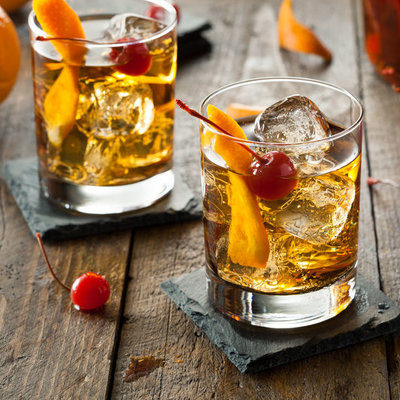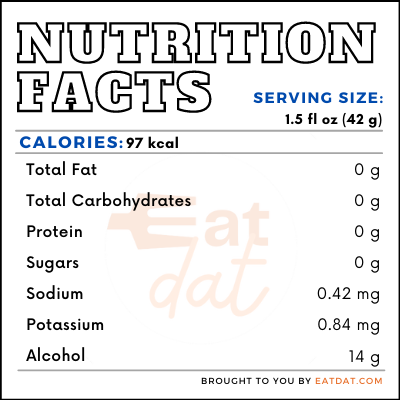
Whiskey
What is Whiskey?
Whiskey is a distilled alcoholic drink made from fermented grain such as wheat, rye, corn, and barley, and aged in wooden barrels. Whiskey contains no additional flavors and must take on the flavors of the barrel.
- The grain used may be malted or not.
- There are different types based on where they are produced, and the type of grain and barrel used.
Some of the main types of whiskey include:
- Malt: This whiskey is mostly produced in Scotland and is made from malted barley. It must be distilled in pot stills.
- Grain: Made in Scotland and Ireland, this whiskey can contain either a single grain or a mixture of grains. Most grain whiskeys use wheat.
- Blended: Also from Scotland and Ireland, these whiskies contain a blend of the above two types. The whiskey gets better as the malt whiskey ratio increases.
- Single Pot Still: An Irish whiskey, these whiskies are distilled in a single pot still.
- Bourbon: Bourbon is produced in the US in the state of Kentucky. There are different types of bourbons, but they must all contain at least 51% corn.
- Tennessee: This is a type of bourbon but is filtered through charcoal before being filled into casks.
- Rye: An American and Canadian production, rye whiskey contains at least 51% rye and must be matured in oak barrels.
- Corn: Produced in the US, this type of whiskey uses 100% corn.
Some of popular brands include:
- Monkey Shoulder
- Glenfiddich
- Balvenie
- Kinivie
- Hudson
- Red Spot
- Glenmorangie
- Suntory
- J. Henry & Sons
Origin of whiskey
Whiskey comes from the Gaelic word ‘uisge beatha’, which means water of life. While distilled spirits have a long history with their origins in medieval Arabia, the type of distilled alcohol that defines this alcohol today originated in Ireland or Scotland. It is first mentioned in an Irish document called Annals of Clonmacnoise in 1405.
By the end of the 15th century, its production gained traction in Scotland. Irish immigrants brought along their whiskey distilling knowledge with them to America. Today, this is consumed all over the world, with the top producing nations being Scotland, Ireland, Japan, India, Finland, Germany, Australia, Canada, USA, and Taiwan.
Commercial production
This beverage is always produced commercially since there are plenty of regulations governing its production. It requires three basic ingredients: grain, water, and yeast. Production has five major steps:
- Malting: The grain goes through germination, during which the starch in the grain is converted into soluble sugar.
- Mashing: The malted grain is added to warm water and stirred. This mixture is known as mash and it ultimately produces wort.
- Fermentation: The cooled wort is put into large tanks to which yeast is added for fermentation.
- Distillation: The distillation process takes place in stills made of copper.
- Maturation: The final step is to put the ready whiskey into oak casks and stored for a period of at least three years.
Nutrition
The nutritional value for 42 g of whiskey:

Because this drink is distilled in copper stills, it contains copper, which helps in the creation of red blood cells, absorbs iron, boosts the immune system, and protects cells. It prevents the onset of anemia and osteoporosis. It also contains antioxidants, which help prevent heart diseases. The drink also controls urate levels by promoting excretion of urate through urine. This can prevent gout and other uric acid diseases.
However, it is not recommended to drink whiskey on a regular basis. Overconsumption of alcohol can lead to several health problems, including affecting the brain’s functioning patterns and general lowering of immunity. The recommended intake for whiskey is 2 standard drinks a day for women and 3 for men, wherein a standard drink is 30 ml. Men should not exceed more than 15 drinks a week and women to 10.
Whiskey recipes
This drink is used extensively in cocktails, as well as in different recipes. Here are a few recipes:
FDA regulations
Whiskey does not completely fall under FDA regulations in the US unless it is an artisanal product. Instead, production has to comply with the TTB (Alcohol and Tobacco Tax and Trade Bureau) requirements. There are strict regulations regarding the governing the production and its labeling depending on the contents. However, the general definition of whiskey is that it is a distilled spirit made from a fermented mash of grain with less than 95% ABV and more than 40% ABV.
References
Types of Whiskies, Whisky.com, https://www.whisky.com/information/knowledge/production/types-of-whiskies/overview-types-of-whiskies.html
Mäkelä, Pia et al. “A bottle of beer, a glass of wine or a shot of whiskey? Can the rate of alcohol-induced harm be affected by altering the population’s beverage choices?.” Contemporary drug problems vol. 38,4 (2011): 599-619. doi:10.1177/009145091103800408, https://www.ncbi.nlm.nih.gov/pmc/articles/PMC3888958/
Heart Foundation New Zealand, Alcohol and the Heart, https://www.heartfoundation.org.nz/wellbeing/healthy-eating/nutrition-facts/alcohol-and-the-heart
